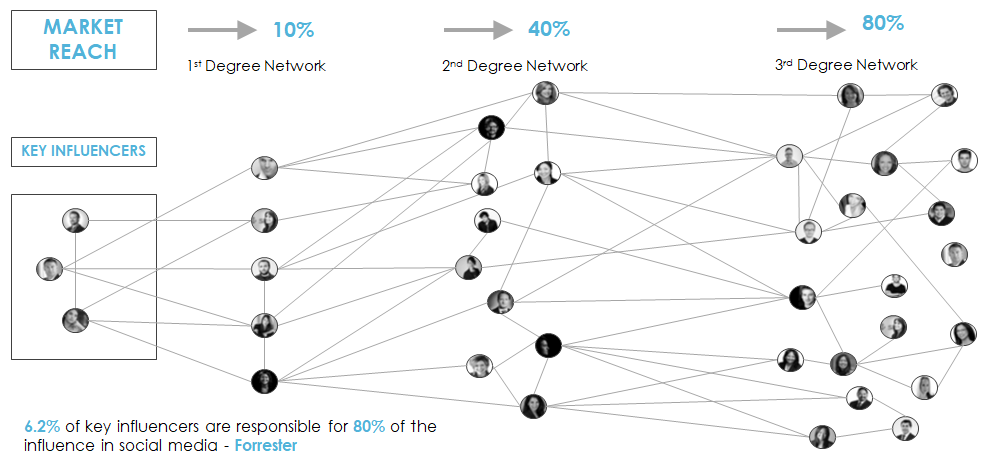The New York Times recently published an article called: “The Follower Factory” exploring the growing demand for purchasing fake followers and engagement across social media platforms.
The article hones in on one company in particular, Devumi. Devumi offers Twitter followers as well as views on YouTube, plays on SoundCloud and endorsements on LinkedIn. Devumi has worked with 200,000 customers, including many high profile influencers, actors, athletes, models and musicians (direct and through representatives and management) who purchase hundreds of thousands of followers to boost their reach, and ultimately their appeal to brands. We’re not even talking about lots of money; for a mere $225, influencers can purchase 25,000 followers. The brand attention this small investment brings to their profile helps them break even and then some with just one paid gig. A no brainer to influencers willing to fake it until they make it. These followers comprise of fake bot accounts, more often than not cloning real life, dormant accounts. It is estimated that as many as 15% (48 million) of Twitter’s total users are bot accounts. In November 2017, Facebook reported to have more than double the quantity of fake accounts than they had first anticipated, with a potential 60 million bot accounts roaming their platform. In every social media corner we turn, there are bots.
Why is this happening?
Why are influencers buying their followers? Because having high follower numbers gets your profile noticed by brands that favour this metric. The more followers an influencer has, the more money they’re able to rake in per post. But let’s take a step back. Why do brands want influencers with high follower numbers? Because they want as many eyeballs as possible driving maximum engagement. Why do they want maximum engagement? Because they want action. Whether this be: increased brand awareness, product interest, product purchases or website traffic.
News flash – bots do not take action. Bots don’t spend money. Bots are not the target audience that brands are after.
But who do we blame for this? Do we blame Devumi and companies alike for providing such a service? Or is this unfair since Devumi are just fulfilling a demand within the market? Do we blame the influencers, since they’re the ones bringing the demand to Devumi? Or do we blame the brands, viewing influencers as a means to an end and a broadcasting platform – a method no different to advertising, prioritising metrics such as followers and likes that are easy to track.
Regardless of who is to blame, this is a serious industry wide issue that will continue to escalate, unless the industry provides education and solutions. Here are 5 ways in which you can get around this issue when identifying influencers for a successful influencer relationship management program.
1) Peer validation authority
The issue the NY Times has highlighted spans wider than fake followers. These fake followers are also bringing fake engagement, so shifting focus from reach to broad engagement stats won’t quite cut it.
What is important, is focusing not just on engagement rates, but exactly who those engagements are from. What is telling, and a great indicator of true influence, is how well regarded and influential an influencer is deemed to be by their influencer peers – something that we have incorporated into our influencer discovery algorithm at Onalytica. If you understand who in the influencer community is influential on each topic, you can effectively map out your influencer community. An influencer with a large, yet fake and un-engaged audience are highly unlikely to be well regarded by their influencer peers; they’re pushing out content that isn’t really driving any real impact in the wider influencer community. A true influencer on the other hand, will be well connected with the well-known industry influencers, with reciprocal engagement on each other’s content. They’ll also be making an impact outside of social media too; creating high quality content with brands, attending and speaking at industry events and being mentioned in the media.
2) Engaged audience data
There is a huge difference between reach (potential audience) and actual reach (engaged viewers).The type and quality of engagement between an influencer’s content and their followers is also extremely important. Influencers with fake engagement are likely to get engagement, without much commentary. Genuine influencers are likely to be pushing out authentic, valuable content that is driving conversation, sparking debates, and getting content shares beyond just likes. Beyond this, their content is likely to inspire other influencers’ content, just like their own content has been inspired by their own influencers.

Tim Williams, CEO, Onalytica
“If you’re paying influencers and your relationship is transactional, then brands need to be very careful about using inaccurate reach and engagement data as their main criteria for selection. By focusing on the engaged audience (not potential reach), relevance, authority and influencer persona, you will be able to select the right influencers that align with your program culture and deliver results. Building organic relationships with influencers based on an equal value exchange requires more effort initially but helps to bypass the obsession with individual reach figures and measures the value they can provide offline as well as online.”
3) Focus on organic, not paid
A large part of this issue is brand mindset, and the way in which they choose to engage with and activate their influencers. A longer term focus on building genuine relationships and alliances with influencers, rather than a short term focus on campaigns will reduce the need to identify influencers with high follower numbers for quick wins. The reason these influencers choose to buy their followers is down to the fact that the kind of brands they work with are willing to pay for quick brand exposure, so understandably prioritise reach. If brands shift their focus from follower numbers to the skill, creativity and knowledge that an influencer can bring to the table, fake influencers will become more obvious and far less appealing.
In order to effectively do this, it is important for brands to understand the different influencer personas and how each shares content. We have categorised the different influencer personas into 5Cs:
- Creators – share their own original content
- Curators – sharing content from others
- Conversation starter – provoke conversation/debate
- Connectors – influencers well connected to the wider influencer community
- Commentators – reacting to industry news, breakthroughs and content
The key is to lay the basis for an equal value partnership in which the influencer, your brand and your target audience has something to gain. This could be giving your influencer a larger platform to showcase their expertise, or by paying to promote influencer generated content to drive targeted traffic and increase the actual reach and awareness.

Philip Brown, Head of Influencer Marketing & Brand Advocacy Strategy at Come Round
“ The time is nearly up for influencer advertising – an industry driven by eyeballs and reach. Now that more accurate data is becoming available to helps us deep-dive into an influencers’ engaged audience, we can finally start pushing the non-authentic, money driven influencers out of the industry and focus more on the long-term, strategic, integrated influencer marketing strategies that cover all layers of influence. The agencies focusing on pay-to-play content creation tactics using mostly talent will see a decline in demand in the upcoming year, and real influencer marketing will (finally) take over. Education pieces like this one contribute greatly to the industry, and this type of education will prove incredibly valuable going into 2018. ’’
4) Topical relevance and authority
Focusing too much on the popularity of an influencer takes focus away from just how relevant that influencer and their audience is to your brand. An influencer may have great popularity and be widely known across a vast array of demographics, but lack influence in a specific topical niche. At Onalytica we prioritise topical relevance and authority when discovering influencers for our clients. What this means, is that we prioritise how relevant and authoritative an influencer is to the specific topics that your brand cares about, over their follower number. This ensures that their follower base is extremely relevant and in line with the kind of audience you wish to be targeting.
An indicator of bot activity is an influencer publishing a high volume of daily posts on a vast array of topics. On the other side of the coin, an influencer that is very influential in a specific area, is likely to publish less frequent, but more focused social media content.
An example: in our 2017 Big Data social media influencer list, we identified David Brin as number one influencer in this space. David Brin is a scientist first, and influencer second. He has a following of 40.6K, with many influencer peers on this list with far more followers than him. On the reach metric alone, many brands, even brands relevant to Big Data, might turn a blind eye to David as his follower number isn’t in the hundreds of thousands. However, David’s 40.6K followers are very relevant to Big Data; his content is also extremely relevant and driving lots of engagement and conversation, more so than his “larger” influencer peers.
Lee Odden, CEO, TopRank Marketing
“Companies relying mostly on reach to determine which influencers to work with are at a gross disadvantage when it comes to finding those who are most relevant and effective. Real influence is the ability to affect action, not simply to be popular. That’s why marketplaces and influencer relationship management platforms that use 3 or more validation criteria beyond follower counts will provide far more relevant, capable and “real” influencers. Topical authority and relevance of influencers as well as the engagement relevance with the network are important considerations. Additional validation includes the relative comparison of influencers to other influencers. Influencer Marketing is a billion dollar plus industry and competition is growing as fast as opportunists seeking to monetize. At the same time, brands partnering with influencers are seeing incredible returns, especially when the influencers are properly vetted and the context of their influence is used to identify, qualify and engage.”
5) Incorporate influencer marketing into your wider strategy
Part of the issue is that influencer marketing is too often looked at as a stand-alone strategy in a silo. Sybil Grieb, Edelman’s U.S. Head of Influencer Strategy and Activation says that the “era of nonstrategic influencer marketing is dying“.
Brands view influencers as a platform and an outlet to broadcast their brand’s message. This creates the foundations for a very un-strategic, transactional process no different to advertising. Incorporating influencer marketing into your content marketing, events marketing, product marketing and social media strategies opens up new opportunities to work with influencers that will drive maximum value and impact for both parties.
Co-create content with your influencers; invite them to your events; use their expertise in your product development, testing and promotion and engage with them and build relationships on social media. The true influencers have so much more to bring to the table than a gone-in-a-moment social media post; they have the potential to create lasting value and drive action amongst those that matter to your brand. So long as there is something valuable to be gained, such as an opportunity to provide value to their audience, or increase their knowledge, they’ll be interested in your brand, without paying a heft cheque.
If you would like to dig deeper and understand your influencers further beyond their reach, get in touch by clicking the button below to enquire about an influencer validation.


